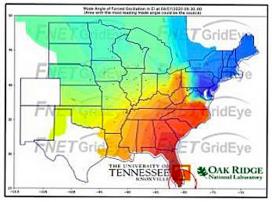New Tool Locates Power Grid Problems, Speeding Solutions and Reducing Downtime
Monitoring oscillation in power generation is essential for reliable system performance. Researchers at the University of Tennessee-Knoxville (UTK) developed an online tool for locating the source of forced oscillation—which can be related to equipment misoperation or failure—and deployed it in U.S. power grids. These efforts were supported by the Center for Ultra-Wide-Area Resilient Electric Energy Transmission Networks (CURENT), a National Science Foundation (NSF) Engineering Research Center (ERC) supported by NSF and the U.S. Department of Energy and headquartered at UTK.
Oscillatory behavior in power systems has been and remains of great interest to engineers and researchers. In the past, most of this interest was placed on modal, i.e., natural, oscillations because of their relationship to system-wide events. A forced oscillation is an unintentional and forced periodic exchange of energy across different components of a power grid, which is symptomatic of the malfunction or mis-operation of equipment. Upon detecting a forced oscillation, the CURENT-UTK tool can generate reports on events, visualize their evolution, alert system operators, and provide detailed event information. Further, the location estimation of the forced oscillation source helps pinpoint the event cause, accelerating resolution of the issue and assisting in post-event analysis.
Multiple severe forced oscillation events have recently been observed across the North American power system interconnections and around the world. These forced oscillations have caused power swings, limited power transfer capability, damaged equipment, and persisted indefinitely until the driving source was located and removed. Based on, The CURENT-UTK researchers used wide-area measurement from the FNET/GridEye sensor network to develop their online tool for locating forced oscillation sources in real-time. When it detects a forced oscillation event, the tool can calculate key indices of the forced oscillation and estimate the source location. FNET/GridEye is a low-cost, quickly deployable GPS-synchronized wide-area frequency measurement network operated by the Power Information Technology Laboratory at the University of Tennessee.



